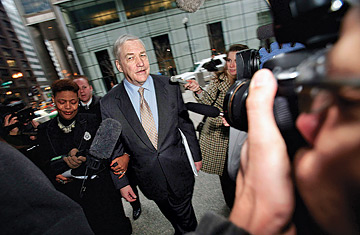
Conrad Black, the press baron accused of looting his Hollinger International media empire, began his current trial in Chicago with at least one thought on his mind. “The prosecutors will soon, finally, have to prove beyond a reasonable doubt the guilt of completely innocent people,” he wrote recently. “They will fail, and justice will be done.” Well, maybe. The strength of the government’s case against him and his co-defendants aside, “beyond a reasonable doubt,” the level of proof required to convict a criminal suspect, may not be as high a barrier between Black and jail as he thinks. Black’s lawyers seem partial to an approach that worked flawlessly for Johnnie Cochran in the O.J. Simpson trial. They’ve suggested that they will create doubt by roughing up the prosecution’s star witness, Black’s former partner David Radler, on the stand, thereby persuading jurors to acquit because the proverbial glove doesn’t fit. It’s a tactic that exploits confusion over the meaning of reasonable doubt–and how much is needed to acquit. Even jurors in the trial of I. Lewis Libby, a well-educated bunch, stumbled over the term’s definition. And it is supposed to make convictions difficult. The Constitution requires the government to be damned sure someone is guilty before taking away his life or liberty. “Reasonable doubt,” though “quantitatively imprecise,” denotes a high “degree of confidence” in a suspect’s guilt, wrote U.S. Supreme Court Justice John Harlan in the 1970 case that gave a constitutional imprimatur to the standard. But in practice, reasonable doubt may make convictions too easy. At least half a dozen studies have found that when the prosecution’s case isn’t airtight, juries often interpret “beyond a reasonable doubt” to mean, in effect, probably guilty. In one study, prospective jurors said they would be willing to convict on a 60% chance that the suspect had committed the crime. The problem: it’s that word, doubt. In a criminal case, prosecutors have the sole burden of proof. Yet the way most courts define “beyond a reasonable doubt” seems to place the burden on the defendant to show a weakness in the prosecution’s arguments. That’s assuming the jury can even figure out what the judge is saying. The jury instructions in the Libby trial were typical of those used across the country. They defined reasonable doubt as “a doubt based on reason–a doubt for which you have a reason based upon the evidence or lack of evidence in the case.” Several similarly unhelpful sentences followed, but the implication was that jurors should look for evidence of doubt. If a defendant doesn’t offer enough, he may get convicted, even when the prosecution’s case is weak. There’s psychology at work here too. Lawrence Solan, a professor at Brooklyn Law School and an expert in linguistics and the law, explains that we can process an abstract word like doubt only by contrasting two mental images. In a criminal case, the first image would be the prosecutor’s version of events, showing the defendant as guilty. The second would portray the defendant as innocent. Only if the second were plausible, says Solan, would the jury have “doubt” about the first. Jurors might themselves be able to conjure the image of the defendant’s innocence, but most need help from his lawyers. Since the defendant isn’t required to offer any scenario at all, the very use of the word doubt may put an unfair burden on him. What’s more, says Solan, we tend to make sense of things by fitting them into stereotypical models, or “prototypes.” We have prototypes for the guilty as well as the innocent. In practice, this means a defendant who “looks more guilty than innocent may be convicted, whether or not the prosecutor proves the elements of the crime,” explains Solan. No one knows how often defendants who don’t offer a plausible version of events and who merely look guilty get convicted, but DNA tests have revealed more than a few false convictions. There are, however, ways to encourage jurors to convict only when proof is strong. Probably the best option would be to shift the inquiry from whether the prosecution’s case evokes doubt to whether it is persuasive. Solan suggests that jurors be “firmly convinced” of guilt, a phrase that focuses on the government’s task rather than a defendant’s . Several states and federal circuits have adopted similar wording. While no conclusive evidence shows how that phrase has affected actual verdicts, several studies indicate that it sets a high bar. It’s too soon for the judge to choose jury instructions in the Black trial. But if she and each side’s lawyers are up on the latest research, and a little bit bold, they’ll consider the “fully convinced” approach. Conrad Black couldn’t ask for more.